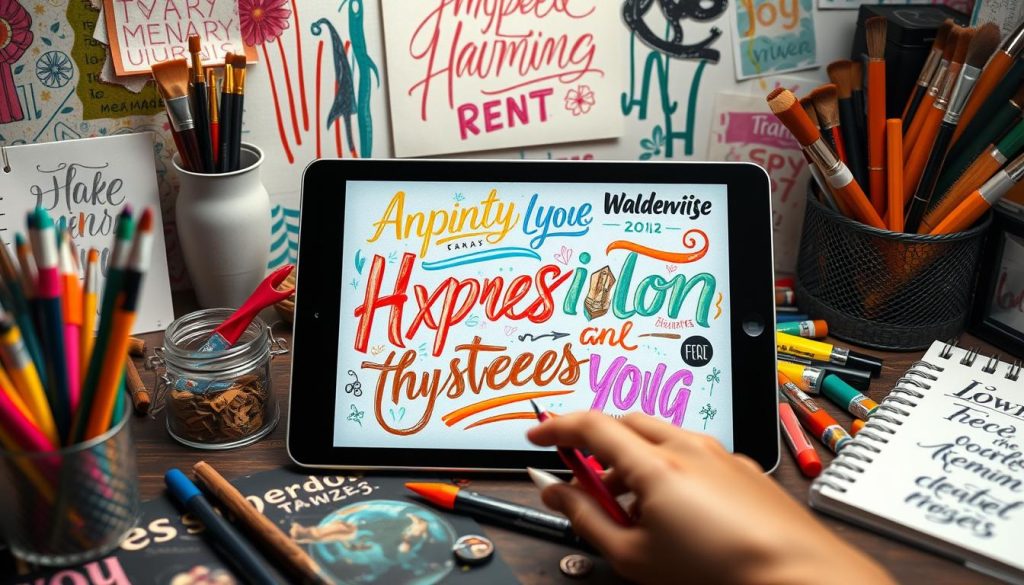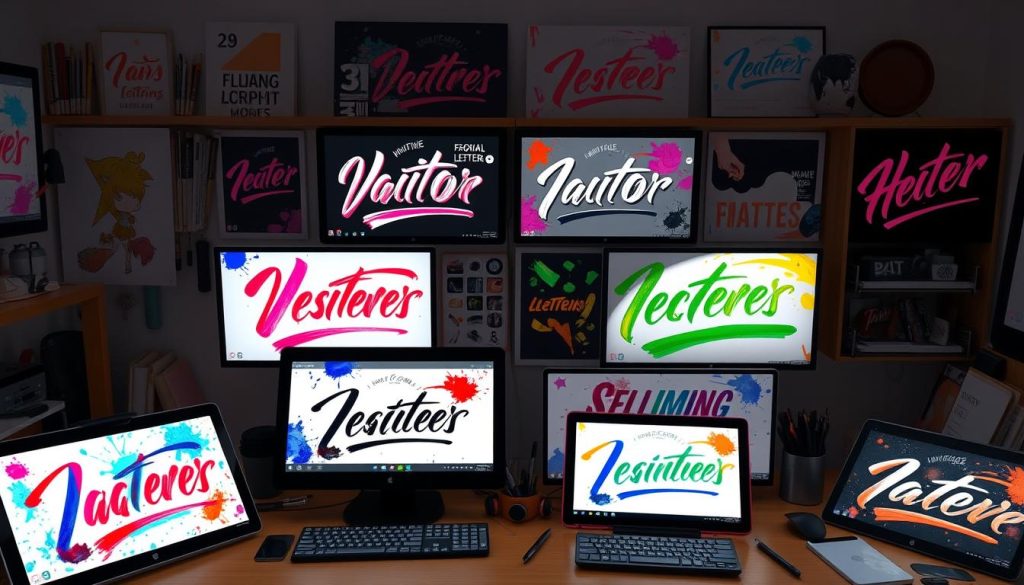Welcome to our journey into the captivating world of lettering in digital art! This skill not only boosts visual communication but also sparks our creativity in many projects. We’ll explore many digital lettering techniques and find top tools to improve our art.
Learning the basics of letter creation will help both students and professionals grow. Let’s explore the vibrant world of digital lettering and unlock our artistic potential!
Understanding the Basics of Lettering in Digital Art

In digital art, lettering is key. It mixes creativity with tech to share ideas through stylish text. Seeing it as art or design, knowing about digital lettering can boost our work.
What is Lettering in Digital Art?
Lettering in digital art means making letters by hand or on a computer, focusing on looks. It’s about creating designs that tell a story or evoke a feeling. Unlike regular fonts, lettering lets artists express themselves freely, making it great for digital calligraphy.
Difference Between Lettering and Typography
Lettering and typography both show text, but they’re used differently. Typography uses known fonts in designs, while lettering is custom-made for a project. This lets artists pick between standard fonts or unique designs that match their vision.
Essential Tools for Digital Lettering
Starting in digital lettering needs the right tools. Adobe Illustrator and Procreate are top picks for artists. Graphics tablets add the detail needed for complex designs. Good tools help us show our style and improve our digital calligraphy.
Exploring Various Digital Lettering Techniques

In this section, we dive into different digital lettering techniques to boost our creative projects. By trying out various methods, we can make stunning designs. We’ll look at digital brush lettering, digital calligraphy, and mixing hand-lettering with digital tools.
Digital Brush Lettering Techniques
Digital brush lettering is a great way to add personality and flow to our designs. It uses digital tools to mimic traditional brush strokes. To get good at it, start with:
- Choosing the right digital brushes that feel like real brushes.
- Practicing pressure sensitivity for varying line thickness.
- Experimenting with different styles and applications to find our unique voice.
Introduction to Digital Calligraphy
Digital calligraphy mixes elegance with modernity. It’s perfect for projects like wedding invitations and logos. For beginners, we suggest:
- Familiarizing ourselves with essential calligraphy styles like Copperplate and Gothic.
- Using specialized software for precision and control.
- Practicing regularly to improve and develop a style.
Mixing Hand-Lettering Styles with Digital Tools
Mixing traditional hand-lettering with digital tools opens up new creative paths. We can mix the warmth of hand-drawn letters with digital flexibility. To blend them well, consider:
- Scanning hand-lettered designs as a base for digital work.
- Using layers in design programs to refine our work.
- Combining textured brushes and vector elements for a unique look.
Choosing the Right Digital Lettering Software

Finding the right digital lettering software is key to great art. There are many choices, each with its own features. We’ll look at popular options and what to consider in digital lettering tools.
Top Software Options for Digital Lettering
Several digital lettering software options are popular among creatives. Here are three top picks:
- Adobe Fresco: Great for all skill levels, it has many brushes and vector tools. It’s a versatile choice for digital lettering.
- Affinity Designer: Known for its easy-to-use design, it has detailed lettering tools. It works well on many devices.
- Clip Studio Paint: It’s all about customization with lots of brushes for different styles. It’s great for comics and illustrations.
Features to Look for in Digital Lettering Software
When looking at digital lettering software, key features to consider are:
- Brush Customization: Customizing brushes lets us create our unique lettering style, from bold to delicate.
- Text Options: Having many fonts and text tools helps us try new things and perfect our designs.
- User-Friendly Interface: A simple interface makes our work flow better. We can focus more on creating and less on navigating.
Tips for Creating Stunning Digital Lettering Designs
To make digital lettering designs stand out, we need to focus on several key areas. Color theory, texture, and choosing the right fonts are all important. Each one plays a big role in making our designs look good and work well.
Incorporating Color Theory into Lettering
Color theory is key for making our digital lettering pop. Using colors that contrast well can make our designs jump out. Colors that go together smoothly can create a sense of peace.
Colors can also affect how people feel. Warm colors like red can make us feel excited. Cool colors like blue can calm us down.
Using Texture and Shadows for Depth
Adding texture and shadows can make our lettering feel more real. Texture makes our designs feel like they have a touchable quality. Shadows add depth and make certain parts of our design stand out.
By playing with blending modes and how transparent our designs are, we can get really creative. This can make our designs truly eye-catching.
Combining Fonts and Styles for Unique Designs
To make our digital lettering truly unique, we should mix different fonts and styles. Pairing a bold script with a simple font can make our designs interesting and easy to read.
Mixing big and small letters can add a fun touch. But, it’s important to keep the spacing and alignment the same. This helps our design look balanced and neat.
| Technique | Purpose | Benefits |
|---|---|---|
| Color Combinations | Establish visual interest | Attracts audience attention |
| Texturing | Add depth and engagement | Creates a tactile feel |
| Font Mixing | Create distinctive styles | Enhances readability and flair |
Best Digital Lettering Tools for Beginners and Professionals
Starting or already skilled in digital lettering, the right tools make a big difference. The Apple iPad Pro with Apple Pencil is top-notch. It’s great for beginners because it’s easy to use and precise.
For experts, Wacom tablets are the way to go. They offer great pressure sensitivity and customization. This means you can control your brushes well and work with many software programs.
Styluses for tablets and touchscreens are also great. They’re perfect for artists who like to work on the move. Finding the right tools is key, whether you’re just starting or have lots of experience. The best tools help us grow our skills and make amazing lettering.


